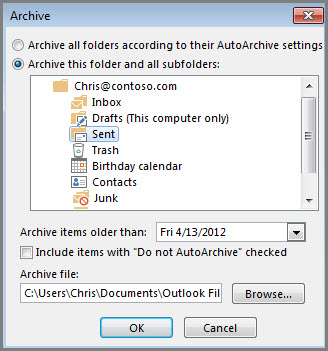
- HOW TO SET UP ARCHIVE FOLDERS IN OUTLOOK 2013 HOW TO
- HOW TO SET UP ARCHIVE FOLDERS IN OUTLOOK 2013 ARCHIVE
Step 1: Run Outlook and click on “FILE” menu seen on the top.
HOW TO SET UP ARCHIVE FOLDERS IN OUTLOOK 2013 ARCHIVE
In AutoArchiving, the emails are automatically moved to archive if user has mentioned the preferred location, the days after which archiving takes place, and so on. Step 5: Click the Browse button if you want to change the default store location for your archive. NOTE: If the user wants to include the folders that are excluded in AutoArchive\, they can enable the check box that reads – Include Items with “Do not AutoArchive” checked. The user can select the folder needed and can change the date accordingly. “Archive this folder and all sub folders”.“Archive all folders according to their AutoArchive settings”.Step 4: Once we select archive, we will get a dialog box as shown below. Step 3: Click on “Archive.” from the drop down menu. Step 2: Click on “Cleanup Tool” box seen on the Account Information page. Step 1: Click on the “FILE” menu once you enter Outlook. NOTE: Once moved the emails won’t be available in their source folder.
HOW TO SET UP ARCHIVE FOLDERS IN OUTLOOK 2013 HOW TO
We’ll see in the coming sections how to archive emails in Microsoft Outlook 2013 and the different types of archiving options offered.īasically there are two types of archiving – Manual Archiving and Auto Archiving With the increase in storage there occurs a slowdown in the performance of Outlook and archiving helps us to prevent it.

Archives reduce the size of the Outlook Data File. So, to increase the availability we can move the mails that may be important but not used so far to another location as an archive.

The Outlook mailbox size increases with the regular exchange of messages. So to make space in Outlook, archiving is the best policy to back up data without any loss.Īrchiving is a process where the current storage of data in a PST file is divided and stored in a separate PST file. The constant exchange of mails leads to exceeding the limit of your mailbox and that affect the performance of application. Outlook and other email clients behave as a mediator for communications. We are used to some form of e-communication. We cannot imagine our lifestyle without the Internet whether it is personal or professional. The maximum size of a PST in Outlook 2010 is 50GB.ĭoes your information in Outlook start disappearing? Most users use an ISP (Internet Service Provider) to connect with the Internet via POP3 and IMAP accounts. PST files stores your data on the computer and basically used by home users or small organization.

Data files that are saved on the server are named OST (Offline Storage Table) and files that are saved in your computer are termed PST (Personal Storage Table). When you work in Outlook all your data is saved on your email server or on your computer. Your archive folder disappears from the Navigation pane.Outlook is primarily used as email application that offers storage and maintenance of emails, contacts, a calendar, journals and so on. The archive data file might be called something other than archive - if so, the name of your particular archive data file will appear instead of the term archive.



 0 kommentar(er)
0 kommentar(er)
